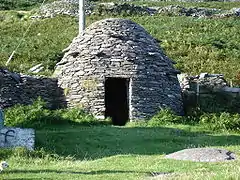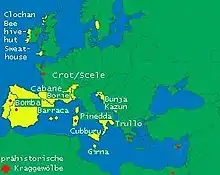
A clochán on Dingle Peninsula, Kerry, Ireland
Types of dry stone hut include:
- Clochán, associated with the south-western Irish seaboard
- Mitato, found in Greece, especially on the mountains of Crete
- Orri, associated with Ariège, France
- Shielings in Scotland
- Trulli, in Apulia, Italy
Uses of dry-stone huts include temporary shelter for shepherds and their animals, permanent habitations for monks or agricultural workers,[1] storage and cheese making. Dry-stone huts may be thatched or roofed with sod, sometimes bound together with plant roots such as those of Madonna lily or sedum.[2]

Distribution in Europe
References
This article is issued from Wikipedia. The text is licensed under Creative Commons - Attribution - Sharealike. Additional terms may apply for the media files.